1.初中英语教师面试:语音课《Ruleoflinking》全英文教案及试讲逐字稿(2020年最新)
初中英语教资面试《试讲》各大课型之语法课教案+逐字稿

初中英语教资面试《试讲》各大课型教案+逐字稿第三章语法课一、例题1.题目:语法教学2.内容:Dad:What will tigers do if they live in the wild?Millie:Tigers will hunt for their own food if they live in the wild.Dad:What will tigers do if they have babies?Millie:Tigers will live as a family if they have babes.Dad:What will male wolves do if there is danger?Millie:Male wolves will protect their families if there is danger.3.基本要求:(1)朗读材料;(2)讲解划线语法;(3)试讲10分钟;(4)注意互动。
二、教案1.Teaching aims(1)Master the new grammar.(key points)(2)Improve listening and speaking skills.(difficult points)(3)Arouse interest in learning English.2.Teaching methodsSituational teaching method,TBLT,communicative teaching method.3.Teaching proceduresStep1.Warm-up and lead-in(1)Sing:<Monsters>.(2)Video:the documentary of BBC.(nature and animals on the earth;animals’behaviors)→Title:Tigers and wolvesStep2.Presentation(1)Find the main idea:What’s the conversation mainly about?(the life of tigers and wolves.)(2)Explain grammar knowledge:A.Show the sentences;B.Read and find similarities in groups.(The length of sentences is similar.)C.Conclude the grammar point:adverbial clause of condition.Step3.Practice(1)Fill in the blanks.(A.Tigers will hunt for their own food if they live in the wild.B.Tigers will live as a family if they have babes…)(2)Pass the ball.make a sentence with the grammar point.Step4.ProductionDiscussion:How about the behaviors of other animals?Step5.Summary and homework(1)Summary:adverbial clause of condition;we should protect nature and wild animals.(2)Homework:the adverbial clause of condition.4.Blackboard design三、逐字稿Step1.Warm-up and lead-inT:Class begins!Boys and girls,how are you today?Oh,you all look tired.Howabout singing a song to cheer up?Are you ready?Let's go!I see your monsters,I see your pain.Tell me your problems,I'll chase them away.I'll be your lighthouse,I'll make it okay.When I see your monsters,I'll stand there so brave,and chase them all away. OK,feel better now?Great,it’s time for class.(And,)At the beginning of the class,I’d like to show you a video.It's taken from the documentary of BBC.Please look at the screen.What can you see in the video?(手指屏幕)Do you know the answer?Yes,nature and animals on the earth.Any others?It tells about the wild animals'behaviors from different aspects and expand our knowledge. Excellent!You know so much about the video.Would you like to learn something more? (回答总结)Today,we are going to learn a new lesson—Tigers and wolves.(板书课题) Step2.PresentationGuys,please open your books.Now,I will show a short material for you.Listen carefully and think about the following question:What’s the conversation mainly about? Now,let's start.(停顿1~2s)(如有朗读要求,此处插入朗读文本)OK,stop here. Who can answer the question?The boy in glasses,you please.It is about the life of tigers and wolves.(复述答案)Agree?Well done!You got the correct answer.(反馈评价) Sit down,please!OK,boys and girls,it's time to learn something new.Here are some new sentences on the screen.(Tigers will hunt for their own food if they live in the wild.Tigers will live as a family if they have babes.Male wolves will protect their families if there is danger.)Now,boys and girls,Can you read these sentences together?Please look carefully and try to find the similarity of them.You can work in groups and share your ideas with each other.2minutes for you.(小组合作探究)Here we go....Stop here.OK!Who wants to be the volunteer?Jenny,you please!Yes,they all contain the word“will”and “if”.You have sharp eyes.Now,let's put all your views together.Look!This is what we will learn today.【名称】We can call it:Adverbial clause of condition.【名称】We use it to talk about the thing happens under certain conditions.For example,if you get up late,you will miss the train.【解释】We should remind that the main clause is the simple future tense and the subordinate clause is the simple present tense.【注意】Step3.PracticePractice makes perfect,so we will do some exercises.let’s“Fill in the blanks. Please finish it as quickly as you can and we will check the answers later.I would give you3minutes,here we go.(间隙中,简要板书出练习的题)Have you finished? What’s your answer,Cindy?Ok,Tigers will hunt for their own food if they live in the wild.Good,any different opinions?All right,but Cindy,please pay attention to the word“live”,not lives.Can you try again?Great,this time is better!Next one?Please tell me together.(Yes,Tigers will live as a family if they have babes.)Wonderful!After doing the exercises,you must be a little tired.Let’s play a game called“Pass the ball”.I will play a music,you should pass the ball to the student behind you,when I stop,who gets the ball should stand up and make a sentence with the grammar point (Adverbial clause of condition).Am I clear?Let's see who is lucky.Ready,go!You are my sunshine,my only sunshine....Stop!Jenny,you are so lucky.If I study hard,I will get good grades.Good.Let’s continue,You make me happy when skies are grey…John,it's your turn.If the weather is fine,I will go out to play basketball.Wow,you all did a very good job!Step4.ProductionSince we have mastered the knowledge well,now,let’s have a discussion.Think about the question:How about the behaviors of other animals?Try to use your imagination to think of more answers.You will work in groups and share your ideas with your group members.Don’t forget to use the grammer we just learned/(Don't forget to use what we just learned).(指向屏幕)You have5minutes.Here we go!(巡视+小提醒)Ok,you are you involved!Who wants to show your group ideas?Jack,you please!Wow,you know so many daily behaviors of different animals.You set a good example for us!(Any volunteers?The girl in the corner,please.Oh,you have good pronunciation and clear logic.)Sit down,please.Step5.Summary and homeworkHow time flies.Now let’s see what we have learned today.Yes,we have learned adverbial clause of condition,Excectly!(And we should protect nature and wild animals, right?Good!)After class,our homework is to search for more imformation about“adverbialclause of condition”on the Internet.Some of you will be invited to share it in the next class.So much for today,goodbye everyone!。
初中英语教师资格面试-语音课逐字稿
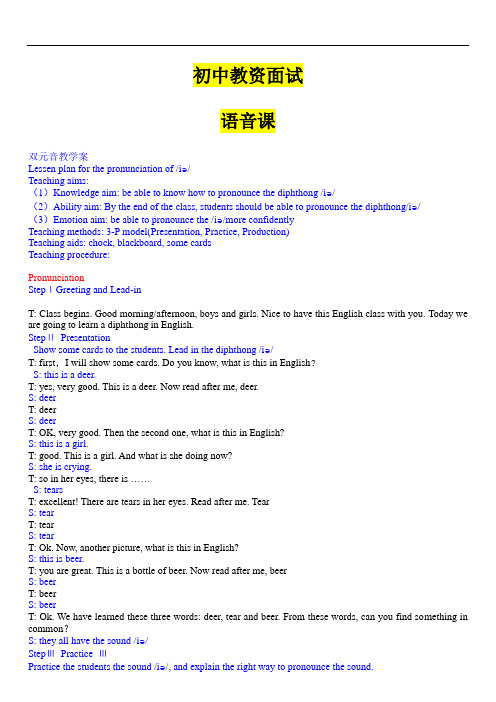
初中教资面试语音课双元音教学案Lessen plan for the pronunciation of /iə/Teaching aims:(1)Knowledge aim: be able to know how to pronounce the diphthong /iə/(2)Ability aim: By the end of the class, students should be able to pronounce the diphthong/iə/(3)Emotion aim: be able to pronounce the /iə/more confidentlyTeaching methods: 3-P model(Presentation, Practice, Production)Teaching aids: chock, blackboard, some cardsTeaching procedure:PronunciationStepⅠGreeting and Lead-inT: Class begins. Good morning/afternoon, boys and girls. Nice to have this English class with you. Today we are going to learn a diphthong in English.StepⅡPresentationShow some cards to the students. Lead in the diphthong /iə/T: first,I will show some cards. Do you know, what is this in English?S: this is a deer.T: yes, very good. This is a deer. Now read after me, deer.S: deerT: deerS: deerT: OK, very good. Then the second one, what is this in English?S: this is a girl.T: good. This is a girl. And what is she doing now?S: she is crying.T: so in her eyes, there is ……S: tearsT: excellent! There are tears in her eyes. Read after me. TearS: tearT: tearS: tearT: Ok. Now, another picture, what is this in English?S: this is beer.T: you are great. This is a bottle of beer. Now read after me, beerS: beerT: beerS: beerT: Ok. We have learned these three words: deer, tear and beer. From these words, can you find something in common?S: they all have the sound /iə/StepⅢPractice ⅢPractice the students the sound /iə/, and explain the right way to pronounce the sound.T: yes, very good. These words all contain the sound/iə/. Now read after me, /iə/ /S: /iə/T: /iə/S: /iə/T: /iə/S: /iə/T: Ok, very good. Now who can pronounce the sound? Cuqi, you, pleaseS: /iə/T: /iə/, read after me.S: /iə/.T: yes, very good. Lyly, can you?S: /iə/.T: OK Good. Xixi, pleaseS: /iə/T: yes, very good.S: /iə/T: OK, excellent. Now, the whole class read after me. /iə/S: /iə/T: /iə/S: /iə/T: good. Now, do you know the right way to pronounce the diphthong /iə/?S: no.T: this is a diphthong. It begins with the first sound /i/,( write the /i/ on the blackboard) and glide towards the second sound /ə/,( write the /ə/ on the blackboard) remember, when you pronounce the Zhaozhao . You, please. diphthong/iə/, you should change the shape of your mouth as you move from one sound to another. Now, / look at the position of my lips when I pronounce this sound. /iə/, /iə/, /iə/. Now read after me, /iə/S: /iə/.T: /iə/.S: /iə/.T: /iə/.S: /iə/T: very good. Now, I will divide you into two groups. Group 1 read the sound three times, and then group 2. Are you clear?S: Yes.T: /iə/. One two go.S: /iə//iə//iə/. / /T: very good. Now group2S:/iə//iə//iə/ / / /StepⅣProductionSound discrimination and tongue twisterT: good. You all have done a good job. Now let’s do some exercise of sound discrimination. Listen to me carefully and circle the words which contain the sound /iə/ from each of the following pairs. N.1, peer pear S: peer, the first one.T: excellent. N.2, tare tearS: the second one.T: are you sure?S: yes.T: OK, very good. N.3deer dareS: the first one.T: great! N.4 mere mareS: mere, the fist one.T: you are so smart. Now, please look at the blackboard. There is a tongue twister. Who can read it out? Miky, you, please.。
教师招聘面试初中英语试讲教案
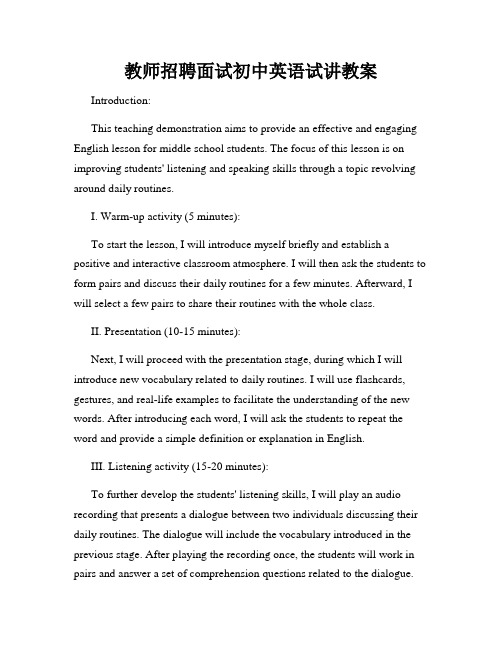
教师招聘面试初中英语试讲教案Introduction:This teaching demonstration aims to provide an effective and engaging English lesson for middle school students. The focus of this lesson is on improving students' listening and speaking skills through a topic revolving around daily routines.I. Warm-up activity (5 minutes):To start the lesson, I will introduce myself briefly and establish a positive and interactive classroom atmosphere. I will then ask the students to form pairs and discuss their daily routines for a few minutes. Afterward, I will select a few pairs to share their routines with the whole class.II. Presentation (10-15 minutes):Next, I will proceed with the presentation stage, during which I will introduce new vocabulary related to daily routines. I will use flashcards, gestures, and real-life examples to facilitate the understanding of the new words. After introducing each word, I will ask the students to repeat the word and provide a simple definition or explanation in English.III. Listening activity (15-20 minutes):To further develop the students' listening skills, I will play an audio recording that presents a dialogue between two individuals discussing their daily routines. The dialogue will include the vocabulary introduced in the previous stage. After playing the recording once, the students will work in pairs and answer a set of comprehension questions related to the dialogue.IV. Speaking activity (15-20 minutes):To engage the students in a speaking activity, I will divide the class into small groups of 4-5 students. Each group will be given a set of picture cards depicting different daily activities. The students will take turns describing the activities using the vocabulary they have learned. This activity will encourage communication and provide an opportunity for the students to practice using the target language.V. Consolidation and extension (10-15 minutes):To consolidate the lesson content, I will create a group activity where students will be given a worksheet with sentences containing missing words related to daily routines. The students will work together to fill in the blanks using the vocabulary and grammar structures learned in previous activities.VI. Conclusion (3-5 minutes):In the final stage of the lesson, I will review the key points and vocabulary covered in the lesson. I will summarize the lesson objectives and ask the students to reflect on what they have learned. To close the lesson on a positive note, I will praise the students' efforts and provide constructive feedback.Overall, this teaching demonstration aims to create an interactive and engaging learning environment for middle school students. Through a combination of listening and speaking activities, students will have an opportunity to practice using the target language related to daily routines. By the end of the lesson, students should feel confident in their ability to understand and discuss daily routines in English.。
1.初中英语教师面试:语音课《Rule of linking 》全英文教案及试讲逐字稿
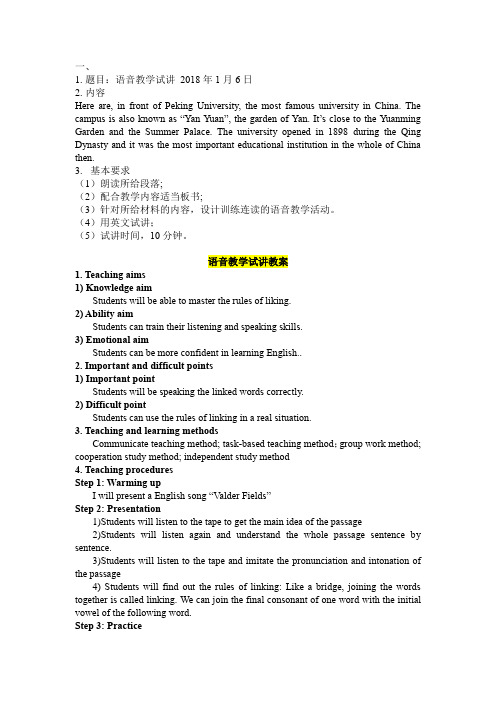
一、1.题目:语音教学试讲2018年1月6日2.内容Here are, in front of Peking University, the most famous university in China. The campus is also known as “Yan Yuan”, the garden of Yan. It’s close to the Yuanming Garden and the Summer Palace. The university opened in 1898 during the Qing Dynasty and it was the most important educational institution in the whole of China then.3.基本要求(1)朗读所给段落;(2)配合教学内容适当板书;(3)针对所给材料的内容,设计训练连读的语音教学活动。
(4)用英文试讲;(5)试讲时间,10分钟。
语音教学试讲教案1. Teaching aims1) Knowledge aimStudents will be able to master the rules of liking.2) Ability aimStudents can train their listening and speaking skills.3) Emotional aimStudents can be more confident in learning English..2. Important and difficult points1) Important pointStudents will be speaking the linked words correctly.2) Difficult pointStudents can use the rules of linking in a real situation.3. Teaching and learning methodsCommunicate teaching method; task-based teaching method;group work method; cooperation study method; independent study method4. Teaching proceduresStep 1: Warming upI will present a English song “Valder Fields”Step 2: Presentation1)Students will listen to the tape to get the main idea of the passage2)Students will listen again and understand the whole passage sentence by sentence.3)Students will listen to the tape and imitate the pronunciation and intonation of the passage4) Students will find out the rules of linking: Like a bridge, joining the words together is called linking. We can join the final consonant of one word with the initial vowel of the following word.Step 3: Practice。
初中英语-教师资格证考试-面试-语音课+写作课备课稿
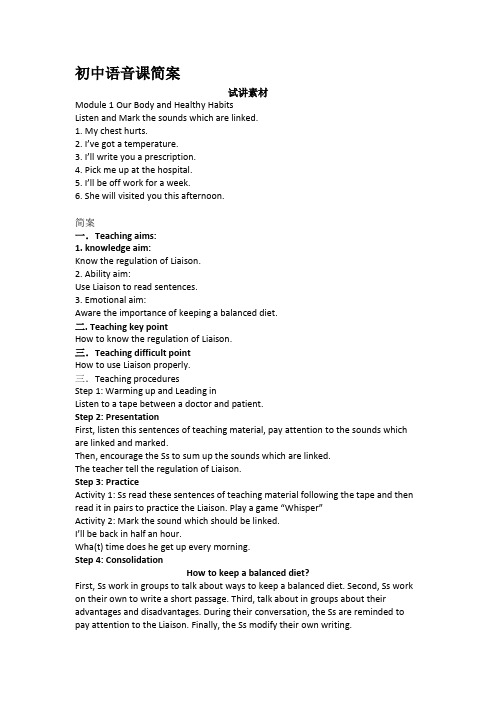
初中语音课简案试讲素材Module 1 Our Body and Healthy HabitsListen and Mark the sounds which are linked.1. My chest hurts.2. I’ve got a temperature.3. I’ll write you a prescription.4. Pick me up at the hospital.5. I’ll be off work for a week.6. She will visited you this afternoon.简案一.Teaching aims:1. knowledge aim:Know the regulation of Liaison.2. Ability aim:Use Liaison to read sentences.3. Emotional aim:Aware the importance of keeping a balanced diet.二. Teaching key pointHow to know the regulation of Liaison.三.Teaching difficult pointHow to use Liaison properly.三.Teaching proceduresStep 1: Warming up and Leading inListen to a tape between a doctor and patient.Step 2: PresentationFirst, listen this sentences of teaching material, pay attention to the sounds which are linked and marked.Then, encourage the Ss to sum up the sounds which are linked.The teacher tell the regulation of Liaison.Step 3: PracticeActivity 1: Ss read these sentences of teaching material following the tape and then read it in pairs to practice the Liaison. Play a game “Whisper”Activity 2: Mark the sound which should be linked.I’ll be back in half an hour.Wha(t) time does he get up every morning.Step 4: ConsolidationHow to keep a balanced diet?First, Ss work in groups to talk about ways to keep a balanced diet. Second, Ss work on their own to write a short passage. Third, talk about in groups about their advantages and disadvantages. During their conversation, the Ss are reminded to pay attention to the Liaison. Finally, the Ss modify their own writing.Step 5: SummaryThe Ss summarize what we have learnt, and the teacher help to complete. Step 6: HomeworkReview what we have learnt.Talk about how to lead a healthy life with their partners in English.初中写作课简案一、Teaching Objectives教学目标1. 1) Master the format/features of letter.2) Review some words about friendship and communication.2. Write a letter about how to keep a good relationship with friends.3. Getting alone well with their classmates or friends.二.Teaching key pointsMaster the features of letters.三.Teaching difficult pointsEnable Ss to write a letter in proper structure.四、Teaching proceduresStep 1: Warming up & Leading inFirstly, show students the letter.T: what’s the features abou t it? And having a discussion.BrainstormStep 2 Pre-writing1. Ss sum up the features of letter, teacher supplement.address, body and signature.2. GeneratingChoose useful information.3. PlanningStructureStep 3 while-writing1. Fast writing2. Group discussion3. ModificationStep 4: Post-writing1. Share your writing2. Writing assessment(1) Can you organize your ideas in logical way?(2) Have you made brainstorm map before writing? Do you think it helpful? Step 5 HomeworkWrite a letter about describing oncoming Spring Festival to your foreign friend Grace.。
教师资格证面试初中英语听说课试讲稿

Listening(板书内容)Part 1:lead-in (板书内容)Step 1 Talk about the topicGive students enough background of the topic .Also let them familiar with the difficult words, especially new words. 了解背景熟悉主题T: Good afternoon, my boys and girls. Welcome back to my class. I am so glad to see you again. Have you had a good weekend? Yeah! Then what did you do during the summer holiday? Sleep, watch TV, or travel with parents? I see. All of you had a wonderful weekend. Well, today I will introduce a new friend to you; let’s s hare what she did durin g the holiday. Now, listen to the tape carefully, and then I’ll ask you some questions. (教师说的内容 ,说完暂停!表示在进行听力,但不要太长,大约数 1、2、 3 秒即可 )Hey, I’m your new friend Tiffany! Last Sunday, I went to the park with my friends for a picnic. We took several bread and some bottles of water with us for lunch. Of course we didn't forget to take some fruits and we even took some tomatoes and cucumbers. It took us thirty minutes to get there by bike. As it was a sunny day, there were lots of people in the park. Firstly, we climbed the mountain and went boating.Then it was the time for lunch,we took out the food and began to prepare our lunch. Though it was not cooked well , we ate happily . When we finished the picnic, we picked up the rubbish and threw it into the dustbin. We thought it was our duty to keep the good environment. We didn’t go home until it was dark. We all enjoyed ourselves. (听力录音材料) T:Ok, do you understand the story ?Yeah! Well, I will ask some you some questions.1. Why did Tiffany and her friends go to the park?2 What did they take to the park ?3 What did they do after the picnic?T: The first question, now who can answer the questions in volunteer? oh, Lily. ( pause ) (平伸右手,手掌朝上,示意学生回答 )Good! Go for a picnic.T: The second question, who want to try? Tom, please. ( pause ) (平伸右手,手掌朝上,示意学生回答) Very good! (右手伸出大拇指,示意回答得很棒 ) bread, bottles 1of water , fruits, tomatoes, cucumbers. Very goodT: The third question, Can you find the answer? Ok , Susan. ( pause ) (平伸右手,手掌朝上,示意学生回答) yes, perfect. (双手伸出大拇指,示意回答得很棒 ) When we finished the picnic, we picked up the rubbish and threw it into the dustbin.Part 2 pre – listening (板书内容)Guess the meaning of the following words (板书内容) 猜测词意扫清障碍Now, you have understood the story well. Let’s look at the details of the text. ① phasesFirst of all, let’s look at the phrases in the text.1. Go for a picnic. Have food outdoors2 By bike it’s an important phrase.“By” plus transport is the meaning of taking transport.For exampleBy bike/train/bus/ship/airplane/foot, no, it is on foot, not by foot.3 pick up take sth upI picked up the money on the ground.Ok so much for the phrases.②important sentencesIt took us thirty minutes to get there by bike.The sentence instruction is :It takes/took sb some time to do sth.And the question sentence of this instruction is:How long does/did it take sb to sth.For example: How long does it take you to go home?It usually takes me 20minutes to go home.Who can make a sentence ?T: Don’t be shy, just have a try. (环顾四周) Tom, do you want to have a try? (Pause)OK!How long does it take you to go to school?Yes, great! It takes me half an hour to go to school. Great, sit down please.2The next sentence is:We didn’t go until it was dark. The sentence instruction is :not until .what’s the meaning of the phrase?直到...才。
初中英语老师试讲模板范文

初中英语老师试讲模板范文Title: Classroom Strategies for Engaging Middle School Students in English Language LearningIntroduction:Good morning, everyone! Today, I am going to share with you some effective classroom strategies that can help engage middle school students in their English language learning journey. These strategies aim to create an interactive and stimulating learning environment, fostering active participation and motivation among the students.Strategy 1: Incorporating TechnologyIn this digital age, students are tech-savvy and thrive on interactive and visually appealing learning experiences. Integrating technology into English language lessons can greatly enhance student engagement. For instance, utilizing educational apps, online platforms, and multimedia resourcescan make language learning more interactive, immersive, and enjoyable for students. Additionally, providing opportunities for online discussions, virtual field trips, andcollaborative projects can further enhance students' language skills while stimulating their interest in the subject matter.Strategy 2: Multisensory LearningMiddle school students often have varying learning styles, and catering to their individual preferences can make the learning process more effective and engaging. Incorporating multisensory activities into the English language lessons can address different learning styles and engage students on multiple levels. For example, incorporating visual aids,hands-on activities, and role-play exercises can helpreinforce language concepts, improve understanding and retention, and make the learning experience more memorableand enjoyable.Strategy 3: Gamification and CompetitionIntroducing elements of gamification and healthy competition into the classroom can significantly increase student motivation and engagement. In English language lessons, teachers can design interactive language games, quizzes, and challenges to test students' knowledge, language skills, and critical thinking abilities. These activities can be conducted individually, in pairs, or even in teams, fostering a collaborative and dynamic learning environment where students actively participate and strive to achieve their goals.Strategy 4: Real-Life ConnectionsMaking connections between what students learn in the classroom and the real world can enhance their understanding, motivation, and engagement. Teachers can incorporate real-life examples, current events, and authentic materials into their English language lessons. For example, discussing relevant topics such as environmental issues, culturaldiversity, or global challenges can make the learning experience more meaningful and relatable for students. Additionally, encouraging students to explore real-world applications of English language skills, such as writing emails, conducting surveys, or participating in debates, can further enhance their engagement and language proficiency.Strategy 5: Differentiated InstructionRecognizing and accommodating students' diverse needs and abilities is vital for maintaining student engagement in the English language classroom. Implementing differentiated instruction strategies allows teachers to tailor their instruction according to individual student needs, interests, and readiness levels. For instance, providing options for project-based learning, offering varied reading materials at different difficulty levels, and incorporating flexible grouping strategies can ensure that each student is appropriately challenged and engaged.Conclusion:Engaging middle school students in English language learning requires implementing various strategies to cater to their diverse needs and interests. Integrating technology, incorporating multisensory activities, incorporating gamification and competition, making real-life connections, and implementing differentiated instruction are effective approaches to create an engaging and dynamic learning environment. By employing these strategies, teachers can foster students' language proficiency, motivation, andoverall enjoyment of the English language learning process. Let's inspire and empower our students as they embark ontheir journey to becoming proficient English language users! Thank you.。
初中英语教师资格面试-语音课教案+讲课+板书模板

初中英语教资面试语音课双元音教学案Lessen plan for the pronunciation of ________Teaching aims:(1)Knowledge aim: be able to know how to pronounce the diphthong ________(2)Ability aim: By the end of the class, students should be able to pronounce the diphthong(记着此处换词)________(3)Emotion aim: be able to pronounce the ________more confidentlyTeaching methods: 3-P modelTeaching aids: chock, blackboard, some cardsTeaching procedure:PronunciationStepⅠGreeting and Lead-in(回答完评委的两个结构化问题,不要再想了!开始上课吧!自己站在讲桌后,右手压左手,自然摆放在腰带扣的地方,也就是肚脐眼的地方,告诉自己放松,再放松!双手越自然越好!气定神怡,平心静气,微笑对评委以及评委身后那不存在还要假装存在的学生,说:)T: Class begins. Good morning/afternoon, boys and girls. Nice to have this English class with you. Today we are going to learn a diphthong(记着此处换词)in English.StepⅡPresentation ⅡShow some cards to the students. Lead in the diphthong(记着此处换词)________T: first,I will show pictures on the blackboard. Do you know, what is this in English?S: this is a________.T: yes, very good. This is a________. Now read after me,________.S:________T:________S:________T: OK, very good. Then the second one, what is this in English?S: this is a ________.T: good. This is a ________. And what is she doing now?S: she is crying.T: so in her eyes, there are ……S: ________T: excellent! There are ________ in her eyes. Read after me. ________S: ________T: ________S: ________T: Ok. Now, another picture, what is this in English?S: this is ________.T: you are great. This is a bottle of ________. Now read after me, ________S: ________T: ________S: ________T: Ok. We have learned these three words:________, ________ and ________. From these words, can you find something in common?S: they all have the sound ________StepⅢPractice ⅢPractice the students the sound ________, and explain the right way to pronounce the sound.T: yes, very good. These words all contain the sound________. Now read after me, ________ /S: ________。
初中英语教师招聘教案全英文
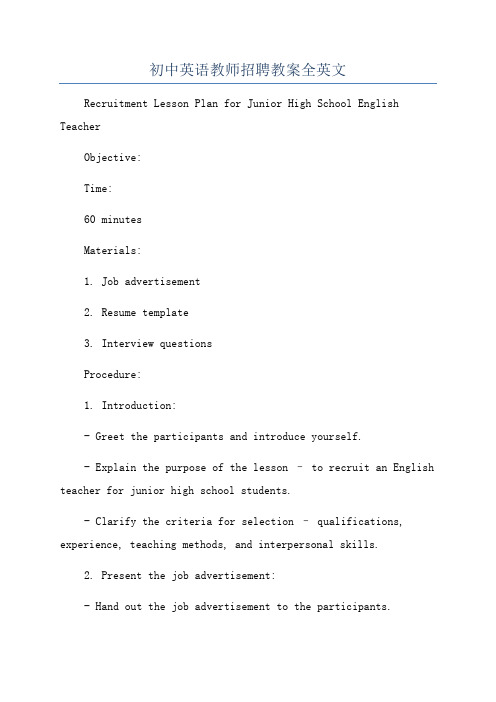
初中英语教师招聘教案全英文Recruitment Lesson Plan for Junior High School English TeacherObjective:Time:60 minutesMaterials:1. Job advertisement2. Resume template3. Interview questionsProcedure:1. Introduction:- Greet the participants and introduce yourself.- Explain the purpose of the lesson – to recruit an English teacher for junior high school students.- Clarify the criteria for selection – qualifications, experience, teaching methods, and interpersonal skills.2. Present the job advertisement:- Hand out the job advertisement to the participants.- Ask the participants to read the job advertisement carefully.- Explain any unfamiliar terms or requirements mentioned in the advertisement.- Emphasize the importance of following the instructions for submitting resumes.3. Resume preparation:- Provide participants with the resume template.- Explain the different sections and their significance in highlighting qualifications and experiences.- Encourage participants to fill in the template with their relevant information, emphasizing their teaching methods and strategies.- Remind participants to proofread their resumes forspelling and grammatical errors.4. Interview preparation:- Explain the interview process and the importance of being well-prepared.- Ask participants to practice answering the questions in pairs or small groups.- Offer feedback and suggestions on their answers.5. Mock Interviews:- Conduct mock interviews with the participants.- Rotate the roles of interviewer and interviewee.- Give feedback and suggestions to each participant after their interview.- Provide participants with opportunities to reflect ontheir performance and areas for improvement.6. Conclusion:- Thank the participants for their active participation.- Clarify any doubts or questions regarding the recruitment process.- Announce the deadline for submitting resumes and any further instructions.- Provide contact information for any clarifications or additional information.7. Follow-up:- Collect the resumes from the participants within the given deadline.- Review the resumes and shortlist candidates for the next phase of the recruitment process.- Contact shortlisted candidates for further interviews, demonstration lessons, or teaching observations.Note: This recruitment lesson plan aims to simulate a real teaching job application process. It provides participants with an opportunity to understand the necessary requirements, prepare their resumes, practice interviewing skills, and receive feedback on their performance. The actual recruitment process may vary based on the policies and procedures of the hiring organization.。
教师资格考试面试初中英语阅读教学试讲逐字稿话术
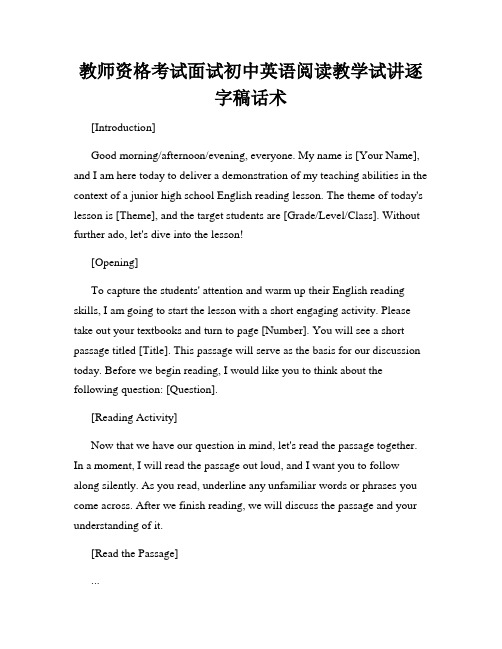
教师资格考试面试初中英语阅读教学试讲逐字稿话术[Introduction]Good morning/afternoon/evening, everyone. My name is [Your Name], and I am here today to deliver a demonstration of my teaching abilities in the context of a junior high school English reading lesson. The theme of today's lesson is [Theme], and the target students are [Grade/Level/Class]. Without further ado, let's dive into the lesson![Opening]To capture the students' attention and warm up their English reading skills, I am going to start the lesson with a short engaging activity. Please take out your textbooks and turn to page [Number]. You will see a short passage titled [Title]. This passage will serve as the basis for our discussion today. Before we begin reading, I would like you to think about the following question: [Question].[Reading Activity]Now that we have our question in mind, let's read the passage together. In a moment, I will read the passage out loud, and I want you to follow along silently. As you read, underline any unfamiliar words or phrases you come across. After we finish reading, we will discuss the passage and your understanding of it.[Read the Passage]...[Checking Students' Understanding]Now that we have finished reading the passage, I would like to ensure that everyone understood the main ideas and details. Let's have a quick comprehension check. I will ask a few questions and please raise your hand to provide the answer. Remember, there are no wrong answers, and your participation is highly encouraged.[Question 1]...[Question 2]...[Question 3]...[Exploring the Passage]Thank you all for your insightful answers. Now, let's take a closer look at certain parts of the passage that may have posed difficulties. I have selected a few vocabulary words and phrases that I believe are crucial for a thorough understanding of the text. Let's examine them together.[Explain Vocabulary]Word/Phrase 1: [Explanation]- Example Sentence: [Sentence]Word/Phrase 2: [Explanation]- Example Sentence: [Sentence]...[Student Interaction]To make sure that everyone has a grasp of the vocabulary, I would like you to work in pairs or small groups. Discuss the meaning of the selected words and phrases within the context of the passage. Use the following sentence stems to guide your discussion:- What is the meaning of [Word/Phrase]?- How does [Word/Phrase] contribute to the understanding of the passage?Please take a few minutes for this activity.[Pair/Group Discussion]...[Whole-Class Discussion]Great discussions, everyone! Now, let's come back together as a class and share our findings. I will randomly call on different groups to present their understanding of the vocabulary words and phrases. Remember to encourage each other and be respectful of different interpretations.[Group Presentations]...[Closure]Before we conclude today's lesson, I want to emphasize the importance of reading and building vocabulary knowledge. Reading helps us develop not only our language skills but also our critical thinking abilities. Remember to read regularly and explore new books, articles, or even online resources.[Final Thoughts]Thank you all for your active participation in today's demonstration lesson. I hope you found it informative and engaging. I thoroughly enjoyed the opportunity to showcase my teaching abilities in the context of a junior high school English reading lesson. If you have any further questions or feedback, please feel free to share them with me. Have a wonderful day![End]。
初中英语教资面试听力课教案+讲课+板书模板

初中英语教资面试听力课模板ListeningPart 1:lead-inStep 1 Talk about the topicGive students enough background of the topic .Also let them familiar with the difficult words, especially new words.了解背景熟悉主题T: Good morning/afternoon, boys and girls. Today, we’ll l earn Unit_____ textbook/workbook Page______. Now who can tell me whether you know about _______? And what does _______ mean?S:(pause).T: Very good, you say it means _________________ In other words, we can say_______________________ (Give another description about the material, if possible, show some body language) Now, let’s look at the following questions.1. What does __________ stand for?2. Do you believe____________________________?3. Have you ever read some reports about _____________ in China?()T: OK. Now who can answer the questions in volunteer?T: The first question, (pause)(平伸右手,手掌朝上,示意学生回答)Good!T: The second question, (pause)(平伸右手,手掌朝上,示意学生回答)Very good! (右手伸出大拇指,示意回答得很棒)T: The third question, (pause)(平伸右手,手掌朝上,示意学生回答)Yes, perfect. (双手伸出大拇指,示意回答得很棒)Step 2 Know more about unexplained things图片展现引起兴趣T: Now, l et’s discuss some unexplained things. First of all, I’ll show pictures of ______. What can you see in the pictures? (pause)T: Yes,it’s about________ _________________________________________________ (To clarify the meaning and arouse students’ interest of ta lking about more unexplained things. If possible, show some body language)Part 2 pre –listening()Guess the meaning of the following words()猜测词意扫清障碍Prepare students for the listening task.听前预测Step 1 Go through the exercise quickly to find the difficult words.浏览材料明确任务T: Today we’ll listen to a passage about _______. Please turn to page_____, I’ll give you one minutes to look through the listening task, and find any difficult words.Now, boys and girls, please exchange your difficult words with each other, and at last I’ll clarify the meaning of the words.T: Ok, time is up. Let’s see the meanings of the words. 处理分歧确定答案eg: province:省份disappear:消失distant:遥远的alien 外星人_______means____ _______means____ _______means_____ _______means ______ _______means______ ()边板书边念,单词不要太多,4、5个即可Part 3 While-listeningLet students focus on the specific information and grasp the skills. 听力实践T: Now, please listen to the tape for the first time and fill the blanks on Page ___(pause)集中信息摘要填空T: Now, let’s listen again and read the statements and find the difficult words. (pause)反复细听突破难点T: If you meet difficulties points in the listening material. Please check in groups and report to your group, let’s solve the questions together. (pause)(走下讲台,转转) 讨论交流Part 4 Post- listeningStep 1 Discuss:T: Well, just now, what did you find most difficult when listening? 反思难点寻求方法Now please exchange your ideas, by discussing the difficulties,which lies in listening , and know how to overcome the difficulties.Please discuss your opinions in pairs.(pauses)(环顾四周)信息反馈各抒已见Step 2Try to think:T: OK, I’ll ask a question, what should we pay attention to when we are listening? ( conclude the ways of listening )T: The first question, (pause)(平伸右手,手掌朝上,示意学生回答)Good!Role play: 角色扮演内容总结T: Now, I’ll ask one student to play the role of a journalist to report this piece of material. Who will try? Ok, Kate, please.(pause)(平伸右手,手掌朝上,示意学生回答)Very good! (右手伸出大拇指,示意回答得很棒)Part 5: ConsolidateChallenge yourself巩固提升复述材料挑战自我T: Now, who can tell us ”What’s the passage mainly about?” Please give your answer in a complete sentence with “The passage tells us…………….”T: Who will try? Don’t be shy! (环顾四周)Tom, do you want to have a try?(pause)OK!(Pretend to be listening)T: Very good! Your answer is wonderful!(右手伸出大拇指,示意回答得很棒)T: Tom said” The passage tells us______________________________________________”Part 6: HomeworkT: Ok, so much for the passage. After class, please use the words of the passage to write a story about ________in 50 words评委老师可能问的问题:小组讨论怎么组织的?。
初中英语教资面试语音课教案+讲课+板书模板

初中英语教资面试语音课双元音教学案Lessen plan for the pronunciation of ________Teaching aims:(1)Knowledge aim: be able to know how to pronounce the diphthong ________(2)Ability aim: By the end of the class, students should be able to pronounce the diphthong(记着此处换词)________(3)Emotion aim: be able to pronounce the ________more confidentlyTeaching methods: 3-P modelTeaching aids: chock, blackboard, some cardsTeaching procedure:PronunciationStepⅠGreeting and Lead-in(回答完评委的两个结构化问题,不要再想了!开始上课吧!自己站在讲桌后,右手压左手,自然摆放在腰带扣的地方,也就是肚脐眼的地方,告诉自己放松,再放松!双手越自然越好!气定神怡,平心静气,微笑对评委以及评委身后那不存在还要假装存在的学生,说:)T: Class begins. Good morning/afternoon, boys and girls. Nice to have this English class with you. Today we are going to learn a diphthong(记着此处换词)in English.StepⅡPresentation ⅡShow some cards to the students. Lead in the diphthong(记着此处换词)________T: first,I will show pictures on the blackboard. Do you know, what is this in English?S: this is a________.T: yes, very good. This is a________. Now read after me,________.S:________T:________S:________T: OK, very good. Then the second one, what is this in English?S: this is a ________.T: good. This is a ________. And what is she doing now?S: she is crying.T: so in her eyes, there are ……S: ________T: excellent! There are ________ in her eyes. Read after me. ________S: ________T: ________S: ________T: Ok. Now, another picture, what is this in English?S: this is ________.T: you are great. This is a bottle of ________. Now read after me, ________S: ________T: ________S: ________T: Ok. We have learned these three words:________, ________ and ________. From these words, can you find something in common?S: they all have the sound ________StepⅢPractice ⅢPractice the students the sound ________, and explain the right way to pronounce the sound.T: yes, very good. These words all contain the sound________. Now read after me, ________ /S: ________T: ________S: ________T: ________S: ________T: Ok, very good. Now who can pronounce the sound? Cuqi, you, pleaseS: ________T: ________, read after me.S: ________.T: yes, very good. Lyly, can you?S: ________.T: OK Good. Xixi, pleaseS: ________T: yes, very good.S: ________T: OK, excellent. Now, the whole class read after me. ________S: ________T: ________S: ________T: good. Now, do you know the right way to pronounce the diphthong(记着此处换词)________?S: no.T: this is a diphthong(记着此处换词). It begins with the first sound /i/,( write the /i/ on the blackboard) and glide towards the second sound /ə/,( write the /ə/ on the blackboard) remember, when you pronounce the Zhaozhao . You, please. diphthong(记着此处换词)________, you should change the shape of your mouth as you move from one sound to another. Now, / look at the position of my lips when I pronounce this sound. ________, ________, ________. Now read after me, ________S: ________.T: ________.S: ________.T: ________.S: ________T: very good. Now, I will divide you into two groups. Group 1 read the sound three times, and then group 2. Are you clear?S: Yes.T: ________. One two go.S: ________________________. / /T: very good. Now group2S:________________________ / / /StepⅣProduction ⅣSound discrimination and tongue twisterT: good. You all have done a good job. Now let’s do some exercise of sound discrimination. Listen to me carefully and circle the words which contain the sound ________ from each of the following pairs. N.1, peer pearS: peer, the first one.T: excellent. N.2, tare ________S: the second one.T: are you sure?S: yes.T: OK, very good. N.3deer dareS: the first one.T: great! N.4 mere mareS: mere, the fist one.T: you are so smart. Now, please look at the blackboard. There is a tongue twister. Who can read it out? Miky, you, please.S: a________ and a mare spare mere one second to drink a bottle of ________ without ________.T: very good. A________ and a mare spare mere one second to drink a bottle of ________ without ________. And who would like to try? cuqi, please.S: a________ and a mare spare mere one second to drink a bottle of ________ without ________.T: excellent!StepⅤSummarize ⅤT: today, we have learned the sound ________; remember the right way to pronounce this sound. It begins with the first sound /i/ and glide towards the second sound /ə/, you should practice more after class.StepⅥHomework ⅥPractice the diphthong(记着此处换词)________ with your partner.备注1:2013真题舌侧音(Lateral) 备课写的内容见下面舌尖顶住上齿向外弹出同时声带震动所发的音例如清晰型:letter lesson lowThe tip of the tongue against the upper teeth popped out at the same time, vocal cord vibration sound made by such as clear type: letter lesson low含糊型:ball school bottleVague type Ball School Bottle舌尖顶住上齿龈,让气流从舌头两边通过,所以叫舌侧音。
3.初中英语教师面试:语音课《双元音教学》全英文教案及试讲逐字稿
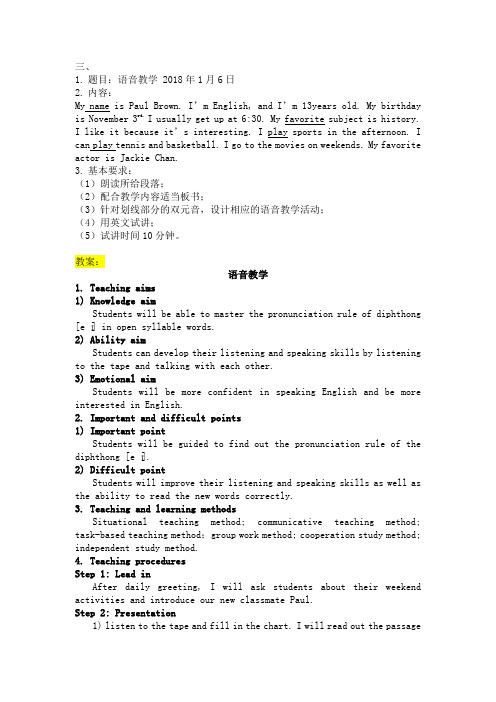
三、1.题目:语音教学 2018年1月6日2.内容:My name is Paul Brown. I’m English, and I’m 13years old. My birthday is November 3rd. I usually get up at 6:30. My favorite subject is history.I like it because it’s interesting. I play sports in the afternoon. I can play tennis and basketball. I go to the movies on weekends. My favorite actor is Jackie Chan.3.基本要求:(1)朗读所给段落;(2)配合教学内容适当板书;(3)针对划线部分的双元音,设计相应的语音教学活动;(4)用英文试讲;(5)试讲时间10分钟。
教案:语音教学1. Teaching aims1) Knowledge aimStudents will be able to master the pronunciation rule of diphthong[e ɪ] in open syllable words.2) Ability aimStudents can develop their listening and speaking skills by listening to the tape and talking with each other.3) Emotional aimStudents will be more confident in speaking English and be more interested in English.2. Important and difficult points1) Important pointStudents will be guided to find out the pronunciation rule of the diphthong [e ɪ].2) Difficult pointStudents will improve their listening and speaking skills as well as the ability to read the new words correctly.3. Teaching and learning methodsSituational teaching method; communicative teaching method; task-based teaching method;group work method; cooperation study method; independent study method.4. Teaching proceduresStep 1: Lead inAfter daily greeting, I will ask students about their weekend activities and introduce our new classmate Paul.Step 2: Presentation1)listen to the tape and fill in the chart. I will read out the passagehere. Students should finish the chart about Paul.2)Pair work. I will underline the words name, favorite and play, then ask students to read these words and find out the correct pronunciation of the letter A.3)Conclude the pronunciation rule. We will analyze the similarities of the three words and conclude the rule.Step 3: PracticeBrian storming. Students will work in groups to think out words which follow the pronunciation rule we learned. And I will explain other pronunciation rules.Step 4: ProductionStudents will write a short passage to introduce themselves and share it in front of class.Step 5: Summary and homeworkI lead them to summarize what they have learned in this class.Homework:Look up in the dictionary to collect more words follow the pronunciation rule we learned today.Write a letter to a pen pal to introduce yourself.5. Blackboard design语音教学试讲稿GreetingGood morning, my dear students. It’s a sunny day, isn’t it? How are you? Pretty good. That is nice. Hope you can enjoy this class.Step 1: Lead inToday is Monday, so what did you do on the weekend? You went to the cinema, Lily. Which movie did you see? The Frozen. Wow, it’s really good. What about you, Eli? You played basketball with friends. Wonderful. Me? My cousin Lucy came back from the US, and I met her son for the first time. Look here, it’s him. He really wants to make friends with you. Do you want to know more about him? Of course.。
中学英语教师资格证面试语音课、写作课简案

中学语音课简案试讲素材Module 1 Our Body and Healthy HabitsListen and Mark the sounds which are linked.1. My chest hurts.2. I’ve got a temperature.3. I’ll write you a prescription.4. Pick me up at the hospital.5. I’ll be off work for a week.6. She will visited you this afternoon.简案一.Teaching aims:1. knowledge aim:Know the regulation of Liaison.2. Ability aim:Use Liaison to read sentences.3. Emotional aim:Aware the importance of keeping a balanced diet.二. Teaching key pointHow to know the regulation of Liaison.三.Teaching difficult pointHow to use Liaison properly.三.Teaching proceduresStep 1: Warming up and Leading inListen to a tape between a doctor and patient.Step 2: PresentationFirst, listen this sentences of teaching material, pay attention to the sounds which are linked and marked.Then, encourage the Ss to sum up the sounds which are linked.The teacher tell the regulation of Liaison.Step 3: PracticeActivity 1: Ss read these sentences of teaching material following the tape and then read it in pairs to practice the Liaison. Play a game “Whisper”Activity 2: Mark the sound which should be linked.I’ll be back in half an hour.Wha(t) time does he get up every morning.Step 4: ConsolidationHow to keep a balanced diet?First, Ss work in groups to talk about ways to keep a balanced diet. Second, Ss work on their own to write a short passage. Third, talk about in groups about their advantages and disadvantages. During their conversation, the Ss are reminded to pay attention to the Liaison. Finally, the Ss modify their own writing.Step 5: SummaryThe Ss summarize what we have learnt, and the teacher help to complete. Step 6: HomeworkReview what we have learnt.Talk about how to lead a healthy life with their partners in English.中学写作课简案一、Teaching Objectives教学目标1. 1) Master the format/features of letter.2) Review some words about friendship and communication.2. Write a letter about how to keep a good relationship with friends.3. Getting alone well with their classmates or friends.二.Teaching key pointsMaster the features of letters.三.Teaching difficult pointsEnable Ss to write a letter in proper structure.四、Teaching proceduresStep 1: Warming up & Leading inFirstly, show students the letter.T: what’s the features about it? And havin g a discussion.BrainstormStep 2 Pre-writing1. Ss sum up the features of letter, teacher supplement.address, body and signature.2. GeneratingChoose useful information.3. PlanningStructureStep 3 while-writing1. Fast writing2. Group discussion3. ModificationStep 4: Post-writing1. Share your writing2. Writing assessment(1) Can you organize your ideas in logical way?(2) Have you made brainstorm map before writing? Do you think it helpful? Step 5 HomeworkWrite a letter about describing oncoming Spring Festival to your foreign friend Grace.。
教资面试初中英语教案模板全英文
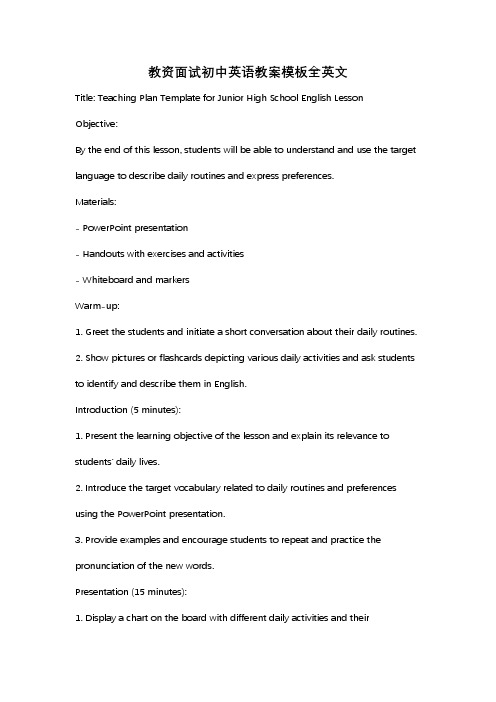
教资面试初中英语教案模板全英文Title: Teaching Plan Template for Junior High School English Lesson Objective:By the end of this lesson, students will be able to understand and use the target language to describe daily routines and express preferences.Materials:- PowerPoint presentation- Handouts with exercises and activities- Whiteboard and markersWarm-up:1. Greet the students and initiate a short conversation about their daily routines.2. Show pictures or flashcards depicting various daily activities and ask students to identify and describe them in English.Introduction (5 minutes):1. Present the learning objective of the lesson and explain its relevance to students' daily lives.2. Introduce the target vocabulary related to daily routines and preferences using the PowerPoint presentation.3. Provide examples and encourage students to repeat and practice the pronunciation of the new words.Presentation (15 minutes):1. Display a chart on the board with different daily activities and theircorresponding time frames.2. Elicit responses from students to complete the chart, ensuring they understand the vocabulary and can use it in context.3. Introduce the target language structures for describing daily routines and expressing preferences.4. Model and provide examples of sentences using the target language, highlighting the correct grammar and sentence structure.Practice (20 minutes):1. Divide the class into pairs or small groups.2. Distribute the handouts with exercises and activities related to the target language.3. Instruct students to complete the exercises individually or in their groups.4. Monitor and provide assistance as needed.5. Conduct a whole-class feedback session to review the answers and address any common mistakes.Production (15 minutes):1. Assign a task where students have to create a dialogue or a short skit using the target language to describe daily routines and express preferences.2. Allow students to work in pairs or small groups to develop their dialogues.3. Encourage creativity and provide guidance when necessary.4. Invite some groups to perform their dialogues in front of the class, while others listen and provide feedback.Conclusion (5 minutes):1. Summarize the key points covered in the lesson.2. Provide feedback and praise for students' efforts during the activities.3. Assign homework that reinforces the target language, such as writing a short paragraph about their own daily routines or completing additional exercises. Note: This teaching plan template can be adapted and modified to suit the specific needs and requirements of different Junior High School English lessons.。
初中英语教资面试语音课教案模板

初中英语教资面试语音课教案模板教案标题:初中英语教资面试语音课教案模板教学目标:1. 学生能够正确发音并掌握英语中的基本语音规则。
2. 学生能够准确区分英语中的元音和辅音,并正确使用它们。
3. 学生能够通过练习提高口语表达的流利度和准确性。
教学重点:1. 英语中的基本语音规则。
2. 元音和辅音的区分及正确发音。
3. 口语表达的流利度和准确性。
教学准备:1. 教学课件或投影仪。
2. 音频材料。
3. 学生练习册。
4. 白板或黑板。
教学过程:Step 1: 引入(5分钟)- 向学生介绍今天的课程内容,即英语语音的学习。
- 提问学生是否遇到过英语发音困难的情况,以激发学生的学习兴趣。
Step 2: 发音规则讲解(10分钟)- 使用课件或黑板,向学生介绍英语中的基本发音规则,例如元音和辅音的发音方式。
- 通过示范和解释,帮助学生理解并掌握这些规则。
- 提供一些常见的例子,让学生听、模仿和发音。
Step 3: 元音和辅音的区分(15分钟)- 向学生解释英语中的元音和辅音的区别,并列举一些常见的元音和辅音的例子。
- 使用音频材料播放这些元音和辅音的发音示范,让学生跟读并纠正他们的发音。
- 通过练习,帮助学生巩固元音和辅音的区分和正确发音。
Step 4: 口语练习(15分钟)- 将学生分成小组,让他们进行口语练习。
- 提供一些口语练习题目,例如简单的问答或对话。
- 鼓励学生在练习中使用正确的发音和流利的口语表达。
Step 5: 总结与评价(5分钟)- 对学生进行总结,复习今天的学习内容,并解答他们可能遇到的问题。
- 向学生提供反馈和评价,鼓励他们在今后的学习中继续努力。
拓展活动:- 鼓励学生在日常生活中多听多说英语,提高他们的口语能力。
- 提供一些在线语音练习资源,供学生在课后进行自主学习和练习。
教学反思:- 教师应注意学生的发音情况,及时纠正错误,并给予正面的鼓励和指导。
- 教师应根据学生的实际水平和学习需求,调整教学内容和难度,以确保教学效果的最大化。
中学英语教师证面试reing试讲

中学英语教师证面试r e i n g试讲LELE was finally revised on the morning of December 16, 2020开场白Good morning, everyone. My name is XXX. It’s my pleasure to stand here and show you my trial teaching. I hope you will enjoy my performance and have a great time here. Now Let’s get ready for class. Today we are going to learn xxx. At first, let’s review the words and phrases in the last class.……Very good. Now, let’s go to the reading part. Please turn to page XXX.(Reading teaching)Let’s have a free talk about XXX---and then discuss the question in pre-reading on page XXX,I will ask someone to talk about your ideas.readingRead the passage as quickly as you can and find the topic sentence of each paragraph.Time’s up. Now, please ask my questions.Questions:’s the general idea of the test?one is the topic sentence of the first paragraph?the passage into 3 parts and think about the main ideas.find out the answers of the questions on page XXX.Step3 Intensive readingRead the passage carefully again and underline the new words and phrases.Now, listen to the tape of paragraph one. Pay attention please.Well, look at the blackboard. These are the new words and phrases of this paragraph. Read after me, XXX go. Now you read it one by one. Let’s start from XXX.Look here please. This is the sentence pattern.I think that sth/sb is(are) … because…How to use itLook at the example.. I think ice cream is junk food, because it has a lot of fat and sugar.)Now, please make sentences by yourself. I will give you 1 minutes.Who would like to tell me your sentence?……Step4. Post-reading.Retell the passage: We’ve read the whole passage deeply. These are the general ideas of all paragraphs. Please communicate with your partner to retell the passage according to the general ideas.Do the exercise on page XXX.Step 5 SummaryLet’s go through the language points of this lesson once again.Step 6. HomeworkChose three newly learnt phrases to make sentences.结束语That’s all for may trial teaching. I've always dreamed to be a teacher,and if I passed the interview, I will have a chance to go further on this soul's journey. Thanks for your listening.。
语音课真题+教案+逐字稿
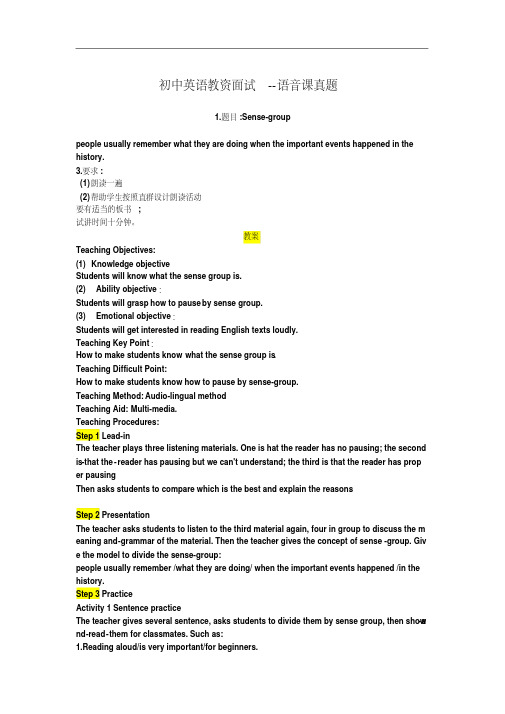
初中英语教资面试--语音课真题1.题目:Sense-grouppeople usually remember what they are doing when the important events happened in the history.3.要求:(1)朗读一遍(2)帮助学生按照直群设计朗读活动要有适当的板书;试讲时间十分钟。
教案Teaching Objectives:(1) Knowledge objectiveStudents will know what the sense group is.(2) Ability objective:Students will grasp how to pause by sense group.(3) Emotional objective:Students will get interested in reading English texts loudly.Teaching Key Point:How to make students know what the sense group is.Teaching Difficult Point:How to make students know how to pause by sense-group.Teaching Method:Audio-lingual methodTeaching Aid: Multi-media.Teaching Procedures:Step 1 Lead-inThe teacher plays three listening materials. One is hat the reader has no pausing; the second is-that the-reader has pausing but we can't understand; the third is that the reader has prop er pausingThen asks students to compare which is the best and explain the reasons.Step 2 PresentationThe teacher asks students to listen to the third material again, four in group to discuss the m eaning and-grammar of the material. Then the teacher gives the concept of sense -group. Giv e the model to divide the sense-group:people usually remember /what they are doing/ when the important events happened /in the history.Step 3 PracticeActivity 1 Sentence practiceThe teacher gives several sentence, asks students to divide them by sense group, then show-a nd-read-them for classmates. Such as:1.Reading aloud/is very important/for beginners.2 Early to bed/and early to rise/makes a man/healthy, happy, and-wiseActivity 2 Passage practiceStudents choose passages that they are interested in to read for classmates in competition.Step 4 Summary and HomeworkSummary: Ask students to conclude what they have learned in the class.Homework; Ask students to listen to a passage of VOA to consolidate how to pause by sense-group after-class.Blackboard Design:板书people usually remember /what they are doing/ when the important events happened/ in the history.语音课逐字稿Good morning,everyone, i am Miss XX. it’s my honor to participate this interview, now iwill begin my class.Good morning boys and girls, i am Miss X, today we will learn english together!How are you today? Ok ,good!In today’s phonetic class we will learn about sense group! Now ,i will read a sentence twice, and tell me which time is easier to understand?The First time:people usually remember what they are doing when the important events happened in the historyThe second time:people usually remember /what they are doing/ when the important events happened /in the history (read with pause)Ok, in which time do you understand the sentence better?Most of you said the second time,why?Because i make a pause between words,right?So what is sense group?According to the m eanings and grammatical structure, a sentence can be divided into several small-pieces,in this sentence, we divide it into 4parts, two clauses leaded by what and when,so we should pause before these two clauses.each small section is called a sense-group.Sense-group can be a word, a phrase, also can be some short-sentences or the clause in a complex sentence. Do you understand?Now i will give you two sentences, read them twice with your partner, make a pause between words if it’s necessary. I will give you 3mins,and then i will ask some of you to show us how do you read these two sentences.Ok, finish? Lily and peter,please read the sentence for us .Excellent! Next sentence, who want to be a volunteer? Ok , kelvin,please!Very good!Now please choose a passage that you are interested in to read for classmates. We are going to compare who is the best! I will give you 3mins to prepare.Ok,let’s welcome the first student...Very good! He put those pause in a correct way!Next one...........Ok, what we have learned today?yes, sense group,,here are your homework:listen to a passage of VOA to consolidate how to pause by sense-group after-class.Class over, goodbye everyone!。
初中英语教师应聘试讲
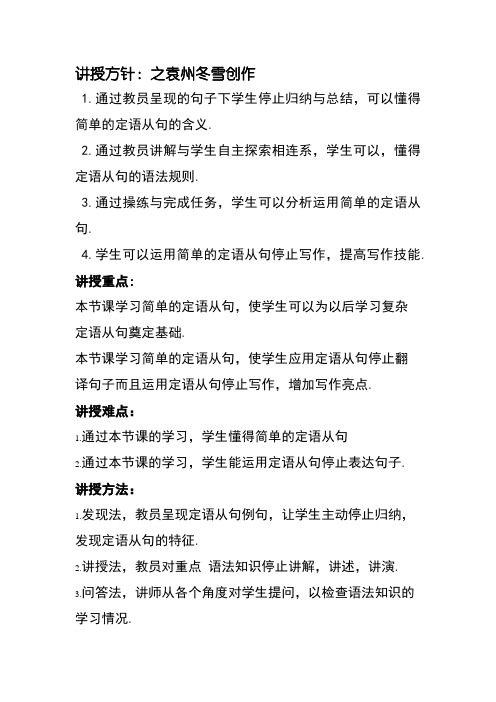
讲授方针:之袁州冬雪创作1.通过教员呈现的句子下学生停止归纳与总结,可以懂得简单的定语从句的含义.2.通过教员讲解与学生自主探索相连系,学生可以,懂得定语从句的语法规则.3.通过操练与完成任务,学生可以分析运用简单的定语从句.4.学生可以运用简单的定语从句停止写作,提高写作技能.讲授重点:本节课学习简单的定语从句,使学生可以为以后学习复杂定语从句奠定基础.本节课学习简单的定语从句,使学生应用定语从句停止翻译句子而且运用定语从句停止写作,增加写作亮点.讲授难点:1.通过本节课的学习,学生懂得简单的定语从句2.通过本节课的学习,学生能运用定语从句停止表达句子. 讲授方法:1.发现法,教员呈现定语从句例句,让学生主动停止归纳,发现定语从句的特征.2.讲授法,教员对重点语法知识停止讲解,讲述,讲演.3.问答法,讲师从各个角度对学生提问,以检查语法知识的学习情况.4.操练法,教员给予适当的操练以巩固定语从句知识.、讲授过程3.导入Gooodafter noon everybody , nice to meet you . Today ,we will learn attributive clause.(边说边法资料,并翻译attributive clause) . Firstly , what is attribute ? Look at your material . Then tell me what you find .(给学生两分钟思考,然后回答,给予评价和指导.) Ok ,thanks for your answering . The underlining par is attribute . 在句子中修饰名词或代词的句子成分就是定语.可作定语的成分有adj﹑n﹑pron﹑名词所有格﹑数词﹑不定式﹑分词﹑动名词﹑介词短语﹑adv 等.那末句子做定语从句会怎样呢?2 语法知识点讲解第一个句子1.The tree is very tall . He is climbing it .→ The tree that/which he is climbing is very tall .翻译,他正在爬的阿谁树非常高. The tree is very tall . 是主句 .That/which引导的句子是定语从句,整个句子修饰the tree ,that或which 在从句中做climb 的宾语.2.The boy is my brother . He were here a minute ago . → The boy who were here a minute ago is my brother .提问,请问哪一个是主句?哪一个是定语从句?从句修饰限定谁?Who在从句中做什么成分?3.The woman is my english teacher . You saw her in the park . →The woman who/whom you saw in the park is my enlglish teacher.讲师讲解,翻译主句,从句关系词先行词4.The boy is hapyy . His parents love him very much . → The boy whose parents love him very much .教员请学生翻译句子,并分析句子.总结,上述都是关系代词,引导定语从句,修饰名词或代词,在从句中做主语,宾语,定语(whose代表the boy’s ).5.①We shall remember the days. ②We studied together then.③We shall remember the days when we studied together .①We shall remember the days.④We studied together during the days.⑤We shall remember the days during which westudies together.把句②变成句①的定语从句,句①中的the days做定语从句的先行词.在句②中then指句①中提到的the days,也就是定语从句的先行词,then在句中做时间状语,因此要用when引导定语从句,代替句②中的then,也就是说then就不克不及出现在定语从句中了.由此得到句③We shall remember the days when we studied together.句②还可以写作句④We studied together during the days.(介词短语during the days含义为“在这些日子里”).把句④变成句①的定语从句,因为the days做介词during的宾语,先行词是the days,指物,在定语从句中介词during提前,用关系代词which替代the days,the days就不克不及在定语从句中出现了.由此得到句⑤We shall remember the days during which we studies together.I've always longed for the days. I should be able to be independent then.→I've always longed for the days when I should be able to be independent.第二组:There are moments. I forget all about it then.→There are moments when I forget all about it.6.①I know a garden.②You can find wild strawberries there.③I know a garden where you can find wild strawberries.④You can find wild strawberries in it⑤I know a garden in which you can find wild strawberries.把句②变成句①的定语从句,句①中的agarden做定语从句的先行词.在句②中there指句①中提到的agarden也就是定语从句的先行词,there在句中做地点状语,因此要用where引导定语从句,代替句②中的there,也就是说there就不克不及出现在定语从句中了.由此得到句③I know a garden where you can find wild strawberries.句②还可以写作句④You can find wild strawberries in it(it指句①中的garden,“在花园中”要使用介词短语in the garden).把句④变成句①的定语从句,因为it做介词in的宾语,先行词是agarden,指物.在这种定语从句中介词常常提到定语从句的开端,这时关系代词只能使用which替代it,it就不克不及在定语从句中出现了.由此得到句⑤即:I know a garden in which you can find wild strawberries.请把下面每组的两句话合并为一句,把第二句话变成第一句的定语从句.第一组:This is the village. I was born there.→This is the village where I was born.第二组:The lab is not far from here. The chemist often does experiments there.→The lab where the chemist often does experiments is not far from here.7.①He wanted to know the reason. ②I was late for the reason .③He wanted to know the reason for which I was late.④He wanted to know the reason why I was late.把句②变成句①的定语从句,句①中的the reasons做定语从句的先行词.因为the reason做介词for的宾语,先行词是the reason指物,在定语从句中介词for提前,用关系代词which替代the reason,the reason就不克不及在定语从句中出现了.由此得到句③He wanted to know the reason for which I was late.注意:在定语从句中当先行词为the reason(s),定语从句由for which引导时,可以用why代替for which.由此我们得到句④He wanted to know the reason why I was late.The reason is not very convincing. He came for the reason.→The reason why he came is not very convincing.The reason for which he came is not very convincing.一.翻译句子1.我仍然记得爸爸说过的话.2.正在说话的女孩是我的好朋友.3.我认识的阿谁女孩的爸爸是我的教师.二、合并句子请把下面每组的两句话合并为一句,把第二句话变成第一句的定语从句.1.There came a day.The rain fell at last then.2.This is the hour.The place is always full of women and children then.3.We will start at the point.We left off there.4.Give me one good reason.I should help you for the reason.5.This is the factory.His father works there.6.I don't know the reason.You quarreled with him.7.I'll never forget the days.We studied togetherthen.三、链接高考1.All___is needed is a supply of oil.2.Finally,the thief handed everything___he had stolen to the police.3.In fact the Swede did not understand the three questions____were asked in French.4.Can you tell me the name of the factory___you visited last week?5.His parents wouldn't let him marry anyone___family was poor.6.After living in Paris for 50 years he returned to the small town____he grew up as a child.7.The film brought the hours back to me____I was taken good care of in that far-away village.。
- 1、下载文档前请自行甄别文档内容的完整性,平台不提供额外的编辑、内容补充、找答案等附加服务。
- 2、"仅部分预览"的文档,不可在线预览部分如存在完整性等问题,可反馈申请退款(可完整预览的文档不适用该条件!)。
- 3、如文档侵犯您的权益,请联系客服反馈,我们会尽快为您处理(人工客服工作时间:9:00-18:30)。
一、
1.题目:语音教学试讲2018年1月6日
2.内容
Here are, in front of Peking University, the most famous university in China. The
campus is also known as “Yan Yuan”, the garden of Yan. It’s close to the Yuanming Garden and the Summer Palace. The university opened in 1898 during the Qing
Dynasty and it was the most important educational institution in the whole of China
then.
3.基本要求
(1)朗读所给段落;
(2)配合教学内容适当板书;
(3)针对所给材料的内容,设计训练连读的语音教学活动。
(4)用英文试讲;
(5)试讲时间,10分钟。
语音教学试讲教案
1. Teaching aims
1) Knowledge aim
Students will be able to master the rules of liking.
2) Ability aim
Students can train their listening and speaking skills.
3) Emotional aim
Students can be more confident in learning English..
2. Important and difficult points
1) Important point
Students will be speaking the linked words correctly.
2) Difficult point
Students can use the rules of linking in a real situation.
3. Teaching and learning methods
Communicate teaching method; task-based teaching method;group work method;
cooperation study method; independent study method
4. Teaching procedures
Step 1: Warming up
I will present a English song “Valder Fields”
Step 2: Presentation
1)Students will listen to the tape to get the main idea of the passage
2)Students will listen again and understand the whole passage sentence by
sentence.
3)Students will listen to the tape and imitate the pronunciation and intonation of
the passage
4) Students will find out the rules of linking: Like a bridge, joining the words
together is called linking. We can join the final consonant of one word with the initial
vowel of the following word.
Step 3: Practice。
